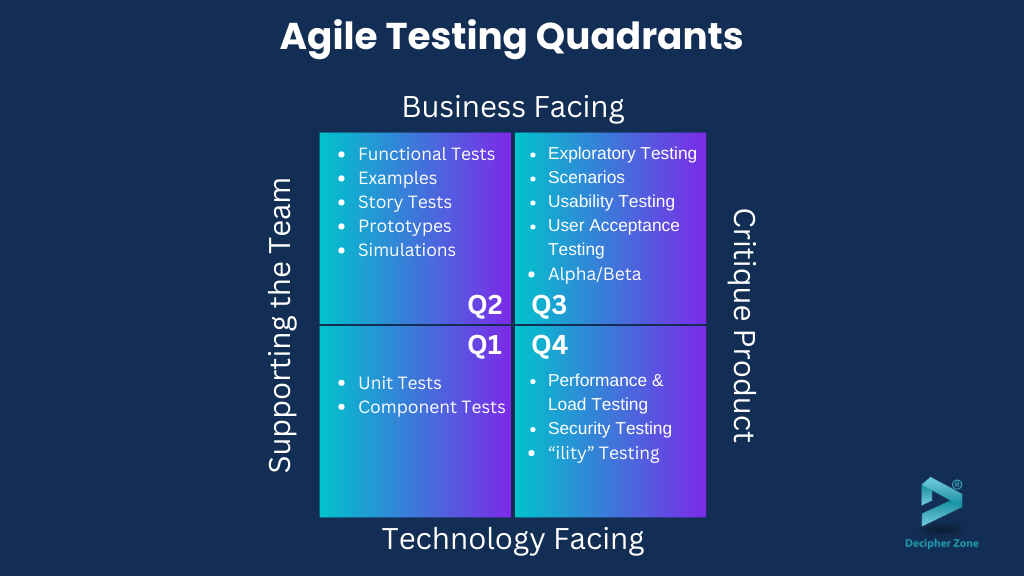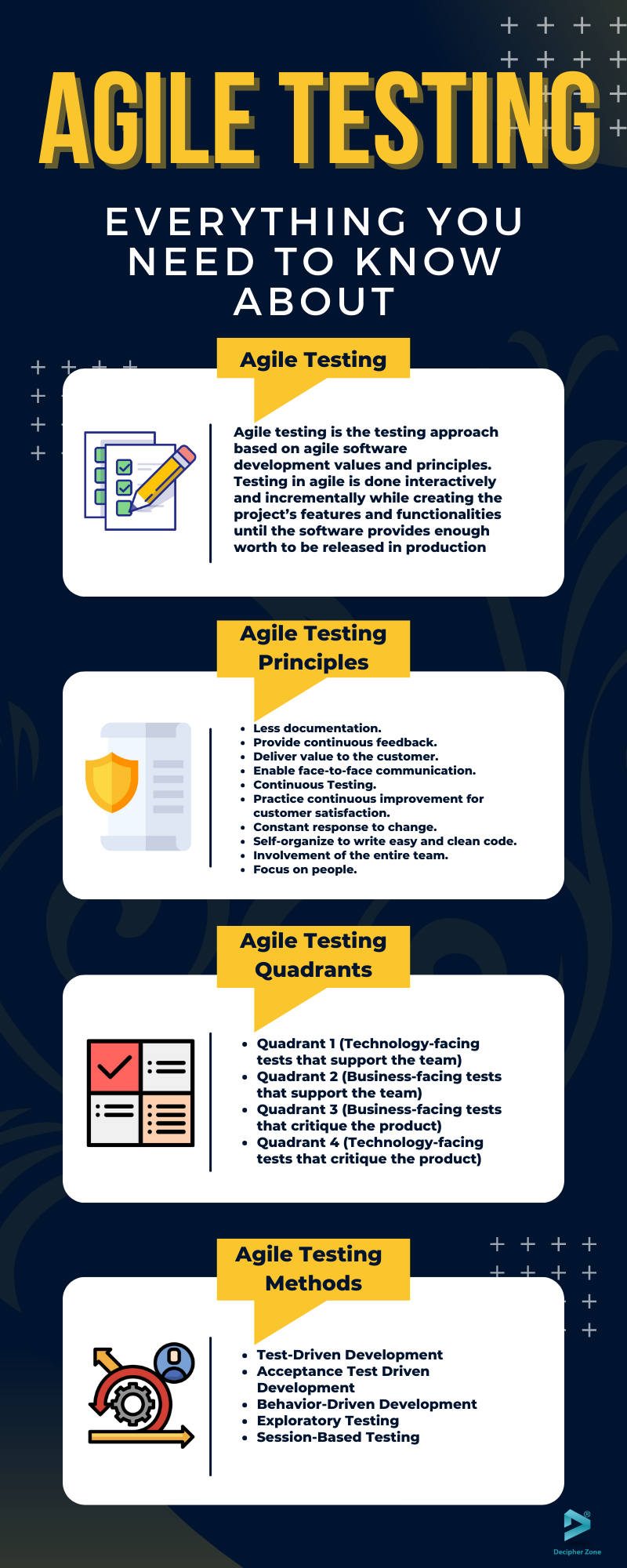You have probably heard the term ‘Agile’ but do you know what it means?
In general terms, Agile refers to the ability to create and retaliate to change. The writers of Agile Manifesto picked Agile as the tag because it represents the adaptiveness of the approaches based on the changes.
According to Agile Manifesto, Agile is the way to discover better ways to create software. The values followed by Agile are
-
Individuals and Interactions OVER Processes and Tools
-
Working Software OVER Comprehensive Documentation
-
Customer Collaboration OVER Contract Negotiation
-
Responding to change OVER Following a Plan
These values make much sense, given agile refers to the flexibility of thinking and moving quickly as per the demands. But developing software requires testing to ensure its quality. And agile development requires agile testing.
Read: What is agile software development
You might be thinking what does Agile testing mean, what principles it follows, and how is it beneficial for your business software?
Whether you are using certain agile methods like XP, DSDM, Scrum, FDD, or Crystal, or just adopting some of the practices and principles that make sense for your project situation, this guide will help you in delivering value to the business.
Without further ado, let’s move ahead and give answers to your questions while sharing some other essential information on Agile Testing as well.
Agile Testing: An Introduction
Agile testing is the testing approach based on agile software development values and principles. Testing in agile is done interactively and incrementally while creating the project’s features and functionalities until the software provides enough worth to be released in production.
Read: Stages of the Agile Development Lifecycle
Agile programmers use a test-driven development approach to ensure the code written is of high quality. Using TDD, programmers write a test for smaller functions, check its working, write code that makes it successful, move on to the next functionality, and iterate throughout the software development cycle.
Read: Best Practices for Unit Testing in Java
The values of the agile manifesto mentioned in the previous section can be seen in the working of agile testers as follows:
-
Testers need to work closely with product owners, developers, and customers to know what is being developed for whom and what will make the project successful - “Individuals and Interactions over Processes and Tools.”
-
Testers are not provided with a set of requirements to test against, instead, it becomes their responsibility to carefully define and identify acceptance criteria along with the team and test against them - “Working Software over Comprehensive Documentation”.
-
Agile testers must focus on customers' needs like security, stability, scalability, etc. regardless they have a direct point of connection with them - “Collaborating with Customers Over Contract Negotiation”.
-
All the tests need to be prioritized or reprioritized depending on the end goal of the development team to minimize the risks and enhance customer satisfaction - “Responding to Change Over Following a Plan”.
Agile Testing Principles
Agile principles and values boost the focus on people involved in a project and the way they communicate. An agile team with higher values and principles will have better velocity and morale than a team of poorly functioning yet talented people.
Read: Agile Software Development Team Structure
But, what are these principles?
Agile Manifesto has a list of principles to define the software development approach and the list of agile testing principles is derived from those principles too.
Some of the principles that are important for Agile testers to follow are:
-
Less documentation.
-
Provide continuous feedback.
-
Deliver value to the customer.
-
Enable face-to-face communication.
-
Practice continuous improvement for customer satisfaction.
-
Constant response to change.
-
Self-organize to write easy and clean code.
-
Involvement of the entire team.
-
Focus on people.
Agile Testing Quadrants
Brian Marick created the agile testing quadrants as an evolution of the agile testing matrix. Depending on your business context, they provide ideas on how to test an application.

Agile testing quadrants divide the agile testing methods into four basic quadrants, helping the entire team to communicate while delivering a high-quality product in less time. The order used to number these quadrants has no relation to the timing of different testing that needs to be done.
Read: Best Practices & Tools For DevOps Testing Strategy
The four quadrants are related to one different aspect as shown in the image above. Although there aren’t any strict rules, here’s what each one of the quadrants means.
Quadrant 1 (Technology-facing tests that support the team)
It represents test-driven development and focuses on the quality of internal code and consists of test cases that are driven by technology and can be incorporated for team support. It consists of Unit Tests and Component Tests.
-
Quadrant 2 (Business-facing tests that support the team)
Q2, also called customer-facing tests, is both manual and automated one that consists of tests designed to enhance the result of a business from the created product. It supports the development team at a higher level by defining external features and quality as per user requirements. The core aim here is to focus on testing activities by using examples, functional tests, prototypes, story tests, and simulations.
-
Quadrant 3 (Business-facing tests that critique the product)
By focusing on the perspective a business might have, Q3 proposes techniques the team can use to critique the product. A few techniques used for Q3 are usability testing, exploratory testing, user acceptance testing, alpha and beta testing, and scenario testing.
-
Quadrant 4 (Technology-facing tests that critique the product)
Q4 provides techniques to developers allowing them to criticize the product from a technical point of view. In Q4 programmers tools for security testing, performance testing, accessibility testing, load testing, portability testing, and so on.
Agile Testing Methods
Now that we know the importance and work of Agile testing, it’s essential to understand different methods that can be used for agile testing. So, here’s the list of agile testing methods that one can use in their project:

Read: API Testing, Types & Benefits
Test-Driven Development:
As the name suggests, TDD begins with tests and varies upon the iteration of the development cycle. In test-driven development, three processes are intertwined: coding, testing (writing unit tests), and designing (refactored code that fits the test case).
The whole point of TDD is to design the code until the unit test passes. Moreover, TDD is executed through automated testing tools while implementing code components and units.
Acceptance Test Driven Development
ATDD is similar to TDD workflow, as it requires test creation before writing source code. However, unlike TDD which uses unit tests, ATDD tests include acceptance testing. Once the test is created, developers write code to pass those tests while indulging the required features. In short, ATDD verifies if the code functions according to the user's expectations.
Behavior-Driven Development:
BDD originates from ATDD and TDD that encourages collaboration among customer representatives, developers, and quality assurance experts. In BDD, an application is designed and documented around the experience users want to have. By focusing on requested functionalities, BDD helps developers to avoid excessive code, avoid bloat, lack of focus, and unnecessary features.
With BDD, you can include business stakeholders and end users with little or no software development experience in the input and feedback process. Using BDD in continuous integration and continuous delivery environments may be easier due to this expanded feedback loop.
Exploratory Testing:
It is software testing where testers don't create tests in advance rather they follow their intuitions manually. Exploratory testing is used in Agile testing for investigating, discovering, and learning. Here, testers record what they are doing and save them as tests. In short, you are testing as you go. It is used to identify hidden errors in the software.
It is that testing method that gives testers freedom to explore code and create highly effective test cases. To check different aspects of the software, the exploratory tester creates different tests to be executed on different functionalities and records the process to understand each flow.
Session-Based Testing
It is a software testing method that makes exploratory tests plannable to be used on large-scale software projects. Session-based testing provides quick discovery of defects, management control and reporting, and on-the-go test designs.
Put simply, the core aim of session-based testing is to divide exploratory testing into small sessions of equal duration while creating and defining test cases and strategies for each session to discover errors in minimum time.
Advantages of Agile Testing
Agile testing for software development continues to play a crucial role in the IT industry. And if you are planning to use Agile Testing methods for your business product, it’s important to know the advantages it brings. Some of the benefits that Agile testing has are:
-
Implementing agile testing not only saves time and cost for software development but also makes cost estimation more transparent.
-
With continuous feedback and reviews Agile testing acquires from the end-user, the overall product quality and attributes can be easily improved.
-
The point of daily communication between developers, testers, and product managers helps in identifying issues efficiently.
-
The best part about using Agile testing methods is that it requires minimum documentation as the team focuses on creating unique and relevant test cases as per the user requirements to execute testing.
-
Agile also minimizes the number of bugs and errors while improving the productivity of the software.
-
Moreover, in agile software development, the processes get divided into small parts, restricting developers from going beyond the track, leading to enhanced efficiency and fewer inconsistencies.
-
Lastly, as the close communication between team members becomes critical in Agile testing, working on the project becomes more enjoyable, productive, and happier in return ensures the best ROI and functionalities in the project.
Conclusion
Being agile allows programmers to run tests alongside the functionality development, making it easier to detect bugs in earlier stages. Needless to say, when you involve testers from the initial stage, they get a good idea of what can happen in what scenario and what they will need to test.
So that was all about agile testing methods and how beneficial they can be for both businesses and developers in the long run.
Now, if you are a business owner ready to bring your dream project to life, then get in touch with our experts and hire agile testers and developers with years of experience and expertise in working with different technologies efficiently.

